In Silico Identification of Possible Inhibitors for Protein Kinase B (PknB) of Mycobacterium tuberculosis
Abstract
1. Introduction
2. Materials and Methods
2.1. Structure Identification
2.2. Protein–Ligand Docking Protocol Validation
2.3. Virtual Screening Protocol Optimization
2.4. Virtual Screening for the Identification of Potential PknB Binders
2.5. Molecular Dynamics (MD) Simulations
2.6. MM/GBSA Free Energy Calculations
2.7. Data Analysis
3. Results and Discussion
4. Conclusions
Supplementary Materials
Author Contributions
Funding
Institutional Review Board Statement
Informed Consent Statement
Conflicts of Interest
Sample Availability
References
- Chawla, Y.; Upadhyay, S.; Khan, S.; Nagarajan, S.; Forti, F.; Nandicoori, V.K. Protein Kinase B (PknB) of Mycobacterium tuberculosis Is Essential for Growth of the Pathogen in Vitro as well as for Survival within the Host. J. Biol. Chem. 2014, 289, 13858–13875. [Google Scholar] [CrossRef]
- Kang, C.-M.; Abbott, D.; Park, S.T.; Dascher, C.C.; Cantley, L.; Husson, R.N. The Mycobacterium tuberculosis serine/threonine kinases PknA and PknB: Substrate identification and regulation of cell shape. Genes Dev. 2005, 19, 1692–1704. [Google Scholar] [CrossRef]
- Manuse, S.; Fleurie, A.; Zucchini, L.; Lesterlin, C.; Grangeasse, C. Role of eukaryotic-like serine/threonine kinases in bacterial cell division and morphogenesis. FEMS Microbiol. Rev. 2015, 40, 41–56. [Google Scholar] [CrossRef] [PubMed]
- Baptista, R.; Bhowmick, S.; Jianying, S.; Mur, L. Molecular Docking Suggests the Targets of Anti-Mycobacterial Natural Products. Molecules 2021, 26, 475. [Google Scholar] [CrossRef] [PubMed]
- Antunes, S.S.; Rabelo, V.W.-H.; Romeiro, N.C. Natural products from Brazilian biodiversity identified as potential inhibitors of PknA and PknB of M. tuberculosis using molecular modeling tools. Comput. Biol. Med. 2021, 136, 104694. [Google Scholar] [CrossRef]
- Sumitro, S.B. COMPUTATIONAL DOCKING STUDY OF MULTITARGET BIOACTIVE COMPOUNDS IN INDONESIA TRADITIONAL HERBAL MEDICINE FOR TUBERCULOSIS THERAPY. Int. J. Green Pharm. 2018, 12. [Google Scholar] [CrossRef]
- Brindha, S.; Vincent, S.; Velmurugan, D.; Ananthakrishnan, D.; Sundaramurthi, J.C.; Gnanadoss, J.J. Bioinformatics approach to prioritize known drugs towards repurposing for tuberculosis. Med Hypotheses 2017, 103, 39–45. [Google Scholar] [CrossRef]
- Graves, A.P.; Brenk, R.; Shoichet, B.K. Decoys for Docking. J. Med. Chem. 2005, 48, 3714–3728. [Google Scholar] [CrossRef]
- Chakaya, J.; Khan, M.; Ntoumi, F.; Aklillu, E.; Fatima, R.; Mwaba, P.; Kapata, N.; Mfinanga, S.; Hasnain, S.E.; Katoto, P.D.; et al. Global Tuberculosis Report 2020 – Reflections on the Global TB burden, treatment and prevention efforts. Int. J. Infect. Dis. 2021. [Google Scholar] [CrossRef]
- Emane, A.K.A.; Guo, X.; Takiff, H.E.; Liu, S. Drug resistance, fitness and compensatory mutations in Mycobacterium tuberculosis. Tuberculosis 2021, 129, 102091. [Google Scholar] [CrossRef]
- Le, N.H.; Locard-Paulet, M.; Stella, A.; Tomas, N.; Molle, V.; Burlet-Schiltz, O.; Daffé, M.; Marrakchi, H. The protein kinase PknB negatively regulates biosynthesis and trafficking of mycolic acids in mycobacteria. J. Lipid Res. 2020, 61, 1180–1191. [Google Scholar] [CrossRef]
- Teixeira, N.M.F.S.A.C.A.S.F.S.C.S.S.; Cerqueira, N.M.; Sousa, S.F. Multifunctional Enzymes as Targets for the Treatment of Tuberculosis: Paving the Way for New Anti-TB Drugs. Curr. Med. Chem. 2021, 28, 5847–5882. [Google Scholar] [CrossRef]
- Fernandez, P.; Saint-Joanis, B.; Barilone, N.; Jackson, M.; Gicquel, B.; Cole, S.T.; Alzari, P.M. The Ser/Thr Protein Kinase PknB Is Essential for Sustaining Mycobacterial Growth. J. Bacteriol. 2006, 188, 7778–7784. [Google Scholar] [CrossRef]
- Turapov, O.; Loraine, J.; Jenkins, C.H.; Barthe, P.; McFeely, D.; Forti, F.; Ghisotti, D.E.; Hesek, D.; Lee, M.; Bottrill, A.; et al. The external PASTA domain of the essential serine/threonine protein kinase PknB regulates mycobacterial growth. Open Biol. 2015, 5, 150025. [Google Scholar] [CrossRef]
- Gupta, A.; Pal, S.K.; Pandey, D.; Fakir, N.A.; Rathod, S.; Sinha, D.; Sivakumar, S.; Sinha, P.; Periera, M.; Balgam, S.; et al. PknB remains an essential and a conserved target for drug development in susceptible and MDR strains of M. Tuberculosis. Ann. Clin. Microbiol. Antimicrob. 2017, 16, 1–10. [Google Scholar] [CrossRef]
- Ortiz-Lombardía, M.; Pompeo, F.; Boitel, B.; Alzari, P. Crystal Structure of the Catalytic Domain of the PknB Serine/Threonine Kinase from Mycobacterium tuberculosis. J. Biol. Chem. 2003, 278, 13094–13100. [Google Scholar] [CrossRef]
- Young, T.A.; Delagoutte, B.; Endrizzi, J.A.; Falick, A.M.; Alber, T. Structure of Mycobacterium tuberculosis PknB supports a universal activation mechanism for Ser/Thr protein kinases. Nat. Struct. Mol. Biol. 2003, 10, 168–174. [Google Scholar] [CrossRef]
- Wehenkel, A.; Fernández, P.; Bellinzoni, M.; Catherinot, V.; Barilone, N.; Labesse, G.; Jackson, M.; Alzari, P.M. The structure of PknB in complex with mitoxantrone, an ATP-competitive inhibitor, suggests a mode of protein kinase regulation in mycobacteria. FEBS Lett. 2006, 580, 3018–3022. [Google Scholar] [CrossRef] [PubMed]
- Bruch, E.M.; Petrella, S.; Bellinzoni, M. Structure-Based Drug Design for Tuberculosis: Challenges Still Ahead. Appl. Sci. 2020, 10, 4248. [Google Scholar] [CrossRef]
- Singh, R.; Dwivedi, S.P.; Gaharwar, U.S.; Meena, R.; Rajamani, P.; Prasad, T. Recent updates on drug resistance in Mycobacterium tuberculosis. J. Appl. Microbiol. 2019, 128, 1547–1567. [Google Scholar] [CrossRef] [PubMed]
- Allué-Guardia, A.; García, J.I.; Torrelles, J.B. Evolution of Drug-Resistant Mycobacterium tuberculosis Strains and Their Adaptation to the Human Lung Environment. Front. Microbiol. 2021, 12. [Google Scholar] [CrossRef]
- Tanner, L.; Denti, P.; Wiesner, L.; Warner, D.F. Drug permeation and metabolism inMycobacterium tuberculosis: Prioritising local exposure as essential criterion in new TB drug development. IUBMB Life 2018, 70, 926–937. [Google Scholar] [CrossRef]
- Cerqueira, N.M.F.S.A.; Gesto, D.; Oliveira, E.; Martins, D.S.; Bras, N.; Sousa, S.; Fernandes, P.; Ramos, M.J. Receptor-based virtual screening protocol for drug discovery. Arch. Biochem. Biophys. 2015, 582, 56–67. [Google Scholar] [CrossRef]
- Gurung, A.B.; Ali, M.A.; Lee, J.; Farah, M.A.; Al-Anazi, K.M. An Updated Review of Computer-Aided Drug Design and Its Application to COVID-19. BioMed Res. Int. 2021, 2021, 1–18. [Google Scholar] [CrossRef]
- Sethi, A.; Joshi, K.; Sasikala, K.; Alvala, M. Molecular Docking in Modern Drug Discovery: Principles and Recent Applications. Drug Dis. Dev.-New Adv. 2020. [Google Scholar] [CrossRef]
- Macalino, S.J.; Gosu, V.; Hong, S.; Choi, S. Role of computer-aided drug design in modern drug discovery. Arch. Pharmacal Res. 2015, 38, 1686–1701. [Google Scholar] [CrossRef]
- Talele, T.T.; Khedkar, S.A.; Rigby, A.C. Successful Applications of Computer Aided Drug Discovery: Moving Drugs from Concept to the Clinic. Curr. Top. Med. Chem. 2010, 10, 127–141. [Google Scholar] [CrossRef]
- Prieto-Martínez, F.D.; López-López, E.; Juárez-Mercado, K.E.; Medina-Franco, J.L. Computational Drug Design Methods—Current and Future Perspectives. Comput. Drug Des. Methods 2019, 19–44. [Google Scholar] [CrossRef]
- Martins, F.; Melo, A.; Sousa, S. Identification of New Potential Inhibitors of Quorum Sensing through a Specialized Multi-Level Computational Approach. Molecules 2021, 26, 2600. [Google Scholar] [CrossRef] [PubMed]
- Mysinger, M.M.; Carchia, M.; Irwin, J.; Shoichet, B.K. Directory of Useful Decoys, Enhanced (DUD-E): Better Ligands and Decoys for Better Benchmarking. J. Med. Chem. 2012, 55, 6582–6594. [Google Scholar] [CrossRef]
- Mieczkowski, C.; Iavarone, A.T.; Alber, T. Auto-activation mechanism of the Mycobacterium tuberculosis PknB receptor Ser/Thr kinase. EMBO J. 2008, 27, 3186–3197. [Google Scholar] [CrossRef] [PubMed]
- Lombana, T.N.; Echols, N.; Good, M.C.; Thomsen, N.D.; Ng, H.L.; Greenstein, A.; Falick, A.M.; King, D.S.; Alber, T. Allosteric Activation Mechanism of the Mycobacterium tuberculosis Receptor Ser/Thr Protein Kinase, PknB. Structure 2010, 18, 1667–1677. [Google Scholar] [CrossRef] [PubMed]
- Wlodarchak, N.; Teachout, N.; Beczkiewicz, J.; Procknow, R.; Schaenzer, A.J.; Satyshur, K.; Pavelka, M.; Zuercher, W.; Drewry, D.; Sauer, J.D.; et al. In Silico Screen and Structural Analysis Identifies Bacterial Kinase Inhibitors which Act with β-Lactams To Inhibit Mycobacterial Growth. Mol. Pharm. 2018, 15, 5410–5426. [Google Scholar] [CrossRef]
- Wang, T.; Bemis, G.; Hanzelka, B.; Zuccola, H.; Wynn, M.; Moody, C.S.; Green, J.; Locher, C.; Liu, A.; Gao, H.; et al. Mtb PKNA/PKNB Dual Inhibition Provides Selectivity Advantages for Inhibitor Design To Minimize Host Kinase Interactions, ACS. Med. Chem. Lett. 2017, 8, 1224–1229. [Google Scholar] [CrossRef] [PubMed]
- Wagner, T.; André-Leroux, G.; Hindie, V.; Barilone, N.; Lisa, M.-N.; Hoos, S.; Raynal, B.; Normand, B.V.-L.; O’Hare, H.M.; Bellinzoni, M.; et al. Structural insights into the functional versatility of an FHA domain protein in mycobacterial signaling. Sci. Signal. 2019, 12, eaav9504. [Google Scholar] [CrossRef]
- Jacobsen, D.M.; Bao, Z.-Q.; O’Brien, P.; Brooks, I.C.L.; Young, M.A. Price To Be Paid for Two-Metal Catalysis: Magnesium Ions That Accelerate Chemistry Unavoidably Limit Product Release from a Protein Kinase. J. Am. Chem. Soc. 2012, 134, 15357–15370. [Google Scholar] [CrossRef]
- Yu, L.; Xu, L.; Xu, M.; Wan, B.; Yu, L.; Huang, Q. Role of Mg2+ions in protein kinase phosphorylation: Insights from molecular dynamics simulations of ATP-kinase complexes. Mol. Simul. 2011, 37, 1143–1150. [Google Scholar] [CrossRef]
- Sousa, S.; Ribeiro, A.; Coimbra, J.; Neves, R.; Martins, S.; Moorthy, N.H.N.; Fernandes, P.; Ramos, M.J. Protein-Ligand Docking in the New Millennium – A Retrospective of 10 Years in the Field. Curr. Med. Chem. 2013, 20, 2296–2314. [Google Scholar] [CrossRef]
- Vieira, T.F.; Sousa, S.F. Comparing AutoDock and Vina in Ligand/Decoy Discrimination for Virtual Screening. Appl. Sci. 2019, 9, 4538. [Google Scholar] [CrossRef]
- Li, J.; Fu, A.; Zhang, L. An Overview of Scoring Functions Used for Protein–Ligand Interactions in Molecular Docking. Interdiscip. Sci. Comput. Life Sci. 2019, 11, 320–328. [Google Scholar] [CrossRef] [PubMed]
- Warren, G.L.; Andrews, C.W.; Capelli, A.M.; Clarke, B.; LaLonde, J.; Lambert, M.H.; Lindvall, M.; Nevins, N.; Semus, S.F.; Senger, S.; et al. A Critical Assessment of Docking Programs and Scoring Functions. J. Med. Chem. 2006, 49, 5912–5931. [Google Scholar] [CrossRef] [PubMed]
- Trott, O.; Olson, A.J. AutoDock Vina: Improving the speed and accuracy of docking with a new scoring function, efficient optimization, and multithreading. J. Comput. Chem. 2009, 31, 455–461. [Google Scholar] [CrossRef] [PubMed]
- Verdonk, M.L.; Cole, J.; Hartshorn, M.J.; Murray, C.; Taylor, R.D. Improved protein-ligand docking using GOLD. Proteins: Struct. Funct. Bioinform. 2003, 52, 609–623. [Google Scholar] [CrossRef]
- Bell, E.; Zhang, Y. DockRMSD: An open-source tool for atom mapping and RMSD calculation of symmetric molecules through graph isomorphism. J. Chemin- 2019, 11, 1–9. [Google Scholar] [CrossRef] [PubMed]
- Gaulton, A.; Hersey, A.; Nowotka, M.; Bento, A.P.S.F.F.; Chambers, J.; Mendez, D.; Mutowo, P.; Atkinson, F.; Bellis, L.; Uhalte, E.C.; et al. The ChEMBL database in 2017. Nucleic Acids Res. 2016, 45, D945–D954. [Google Scholar] [CrossRef] [PubMed]
- Gilson, M.K.; Liu, T.; Baitaluk, M.; Nicola, G.; Hwang, L.; Chong, J. BindingDB in 2015: A public database for medicinal chemistry, computational chemistry and systems pharmacology. Nucleic Acids Res. 2015, 44, D1045–D1053. [Google Scholar] [CrossRef] [PubMed]
- Berman, H.M.; Westbrook, J.D.; Feng, Z.; Gilliland, G.; Bhat, T.N.; Weissig, H.; Shindyalov, I.N.; Bourne, P.E. The Protein Data Bank. Nucleic Acids Res. 2000, 28, 235–242. [Google Scholar] [CrossRef] [PubMed]
- Empereur-Mot, C.; Zagury, J.F.; Montes, M. Screening Explorer–An Interactive Tool for the Analysis of Screening Results. J. Chem. Inf. Model. 2016, 56, 2281–2286. [Google Scholar] [CrossRef] [PubMed]
- Sterling, T.; Irwin, J.J. ZINC 15 – Ligand Discovery for Everyone. J. Chem. Inf. Model. 2015, 55, 2324–2337. [Google Scholar] [CrossRef]
- Ortuso, F.; Bagetta, D.; Maruca, A.; Talarico, C.; Bolognesi, M.L.; Haider, N.; Borges, F.; Bryant, S.; Langer, T.; Senderowitz, H.; et al. The Mu.Ta.Lig. Chemotheca: A Community-Populated Molecular Database for Multi-Target Ligands Identification and Compound-Repurposing. Front. Chem. 2018, 6, 130. [Google Scholar] [CrossRef]
- Mahuteau-Betzer, F. Chimiothèque Nationale. Médecine Sci. 2015, 31, 417–422. [Google Scholar] [CrossRef][Green Version]
- Oliveira, I.M.; Borges, A.; Simões, M. The potential of drug repurposing to face bacterial and fungal biofilm infections. Rec. Trends Biofilm Sci. Technol. 2020, 307–328. [Google Scholar] [CrossRef]
- Daina, A.; Michielin, O.; Zoete, V. SwissADME: A free web tool to evaluate pharmacokinetics, drug-likeness and medicinal chemistry friendliness of small molecules. Sci. Rep. 2017, 7, srep42717. [Google Scholar] [CrossRef]
- Pires, D.E.V.; Blundell, T.L.; Ascher, D.B. pkCSM: Predicting Small-Molecule Pharmacokinetic and Toxicity Properties Using Graph-Based Signatures. J. Med. Chem. 2015, 58, 4066–4072. [Google Scholar] [CrossRef] [PubMed]
- Case, D.A.; Cheatham, T.E.C., III; Darden, T.; Gohlke, H.; Luo, R.; Merz, K.M., Jr.; Onufriev, A.; Simmerling, C.; Wang, B.; Woods, R.J. The Amber biomolecular simulation programs. J. Comput. Chem. 2005, 26, 1668–1688. [Google Scholar] [CrossRef] [PubMed]
- Wang, J.; Wolf, R.M.; Caldwell, J.W.; Kollman, P.A.; Case, D.A. Development and testing of a general amber force field. J. Comput. Chem. 2004, 25, 1157–1174. [Google Scholar] [CrossRef] [PubMed]
- Frisch, M.J.; Trucks, G.W.; Schlegel, H.B.; Scuseria, G.E.; Robb, M.A.; Cheeseman, J.R.; Scalmani, G.; Barone, V.; Petersson, G.A.; Nakatsuji, H.; et al. Gaussian 09, Revision A.02.; Gaussian Inc.: Wallingford, CT, USA, 2016. [Google Scholar]
- Maier, J.A.; Martinez, C.; Kasavajhala, K.; Wickstrom, L.; Hauser, K.E.; Simmerling, C. ff14SB: Improving the Accuracy of Protein Side Chain and Backbone Parameters from ff99SB. J. Chem. Theory Comput. 2015, 11, 3696–3713. [Google Scholar] [CrossRef]
- Roe, D.R.; Cheatham, I.T.E. PTRAJ and CPPTRAJ: Software for Processing and Analysis of Molecular Dynamics Trajectory Data. J. Chem. Theory Comput. 2013, 9, 3084–3095. [Google Scholar] [CrossRef] [PubMed]
- Humphrey, W.; Dalke, A.; Schulten, K. VMD: Visual molecular dynamics. J. Mol. Graph. 1996, 14, 33–38. [Google Scholar] [CrossRef]
- The PyMOL Molecular Graphics System; Version 2.0; Schrödinger, LLC: New York, NY, USA, 2015; Available online: https://pymol.org/2/ (accessed on 15 September 2021).
- Miller, I.B.R.; McGee, J.T.D.; Swails, J.M.; Homeyer, N.; Gohlke, H.; Roitberg, A.E. MMPBSA.py: An Efficient Program for End-State Free Energy Calculations. J. Chem. Theory Comput. 2012, 8, 3314–3321. [Google Scholar] [CrossRef]
- Chen, H.; Lyne, P.D.; Giordanetto, F.; Lovell, T.; Li†, J. On Evaluating Molecular-Docking Methods for Pose Prediction and Enrichment Factors. J. Chem. Inf. Model. 2005, 46, 401–415. [Google Scholar] [CrossRef]
- Truchon, J.-F.; Bayly, C.I. Evaluating Virtual Screening Methods: Good and Bad Metrics for the “Early Recognition” Problem. J. Chem. Inf. Model. 2007, 47, 488–508. [Google Scholar] [CrossRef]
- Till, J.H.; Ablooglu, A.J.; Frankel, M.; Bishop, S.M.; Kohanski, R.A.; Hubbard, S. Crystallographic and Solution Studies of an Activation Loop Mutant of the Insulin Receptor Tyrosine Kinase. J. Biol. Chem. 2001, 276, 10049–10055. [Google Scholar] [CrossRef]
- Lipinski, C.; Lombardo, F.; Dominy, B.W.; Feeney, P.J. Experimental and computational approaches to estimate solubility and permeability in drug discovery and development settings. Adv. Drug Deliv. Rev. 1997, 23, 3–25. [Google Scholar] [CrossRef]
- Sander, T.; Freyss, J.; Von Korff, M.; Rufener, C. DataWarrior: An Open-Source Program For Chemistry Aware Data Visualization And Analysis. J. Chem. Inf. Model. 2015, 55, 460–473. [Google Scholar] [CrossRef]
- Hussain, T.; Zhao, D.; Shah, S.Z.A.; Sabir, N.; Wang, J.; Liao, Y.; Song, Y.; Dong, H.; Mangi, M.H.; Ni, J.; et al. Nilotinib: A Tyrosine Kinase Inhibitor Mediates Resistance to Intracellular Mycobacterium Via Regulating Autophagy. Cells 2019, 8, 506. [Google Scholar] [CrossRef]
- Deshpande, D.; Srivastava, S.; Pasipanodya, J.G.; Lee, P.S.; Gumbo, T. Tedizolid is highly bactericidal in the treatment of pulmonary Mycobacterium avium complex disease. J. Antimicrob. Chemother. 2017, 72, i30–i35. [Google Scholar] [CrossRef]
- Compain, F.; Soroka, D.; Heym, B.; Gaillard, J.-L.; Herrmann, J.-L.; Dorchène, D.; Arthur, M.; Dubée, V. In vitro activity of tedizolid against the Mycobacterium abscessus complex. Diagn. Microbiol. Infect. Dis. 2018, 90, 186–189. [Google Scholar] [CrossRef]
- A Molina-Torres, C.; Barba-Marines, A.; Valles-Guerra, O.; Ocampo-Candiani, J.; Cavazos-Rocha, N.; Pucci, M.J.; Castro-Garza, J.; Vera-Cabrera, L. Intracellular activity of tedizolid phosphate and ACH-702 versus Mycobacterium tuberculosis infected macrophages. Ann. Clin. Microbiol. Antimicrob. 2014, 13, 1–5. [Google Scholar] [CrossRef] [PubMed]
- Ruiz, P.; Causse, M.; Vaquero, M.; Casal, M. In Vitro Activity of Tedizolid against Mycobacterium tuberculosis. Antimicrob. Agents Chemother. 2019, 63. [Google Scholar] [CrossRef] [PubMed]
- Flavin Mononucleotide. Available online: https://go.drugbank.com/drugs/DB03247 (accessed on 7 September 2021).
- Koulenti, D.; Xu, E.; Yin Sum Mok, I.; Song, A.; Karageorgopoulos, D.E.; Armaganidis, A.; Lipman, J.; Tsiodras, S. Novel Antibiotics for Multidrug-Resistant Gram-Positive Microorganisms. Microorganisms 2019, 7, 270. [Google Scholar] [CrossRef]
- Thouet, T.; Schnackenburg, B.; Kokocinski, T.; Fleck, E.; Nagel, E.; Kelle, S. Visualization of Chronic Myocardial Infarction Using the Intravascular Contrast Agent MS-325 (Gadofosveset) in Patients. Sci. World J. 2012, 2012, 1–6. [Google Scholar] [CrossRef]
- Adasme, M.F.; Linnemann, K.L.; Bolz, S.N.; Kaiser, F.; Salentin, S.; Haupt, V.J.; Schroeder, M. PLIP 2021: Expanding the scope of the protein–ligand interaction profiler to DNA and RNA. Nucleic Acids Res. 2021, 49, W530–W534. [Google Scholar] [CrossRef] [PubMed]


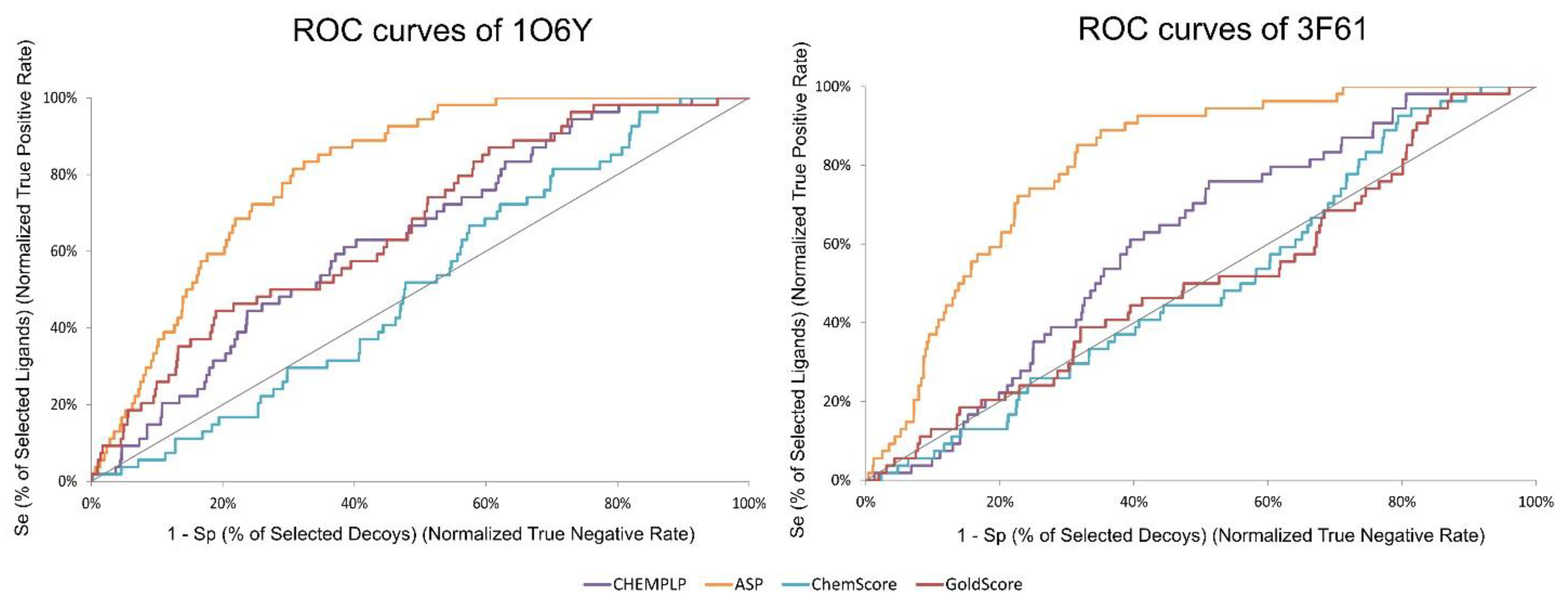


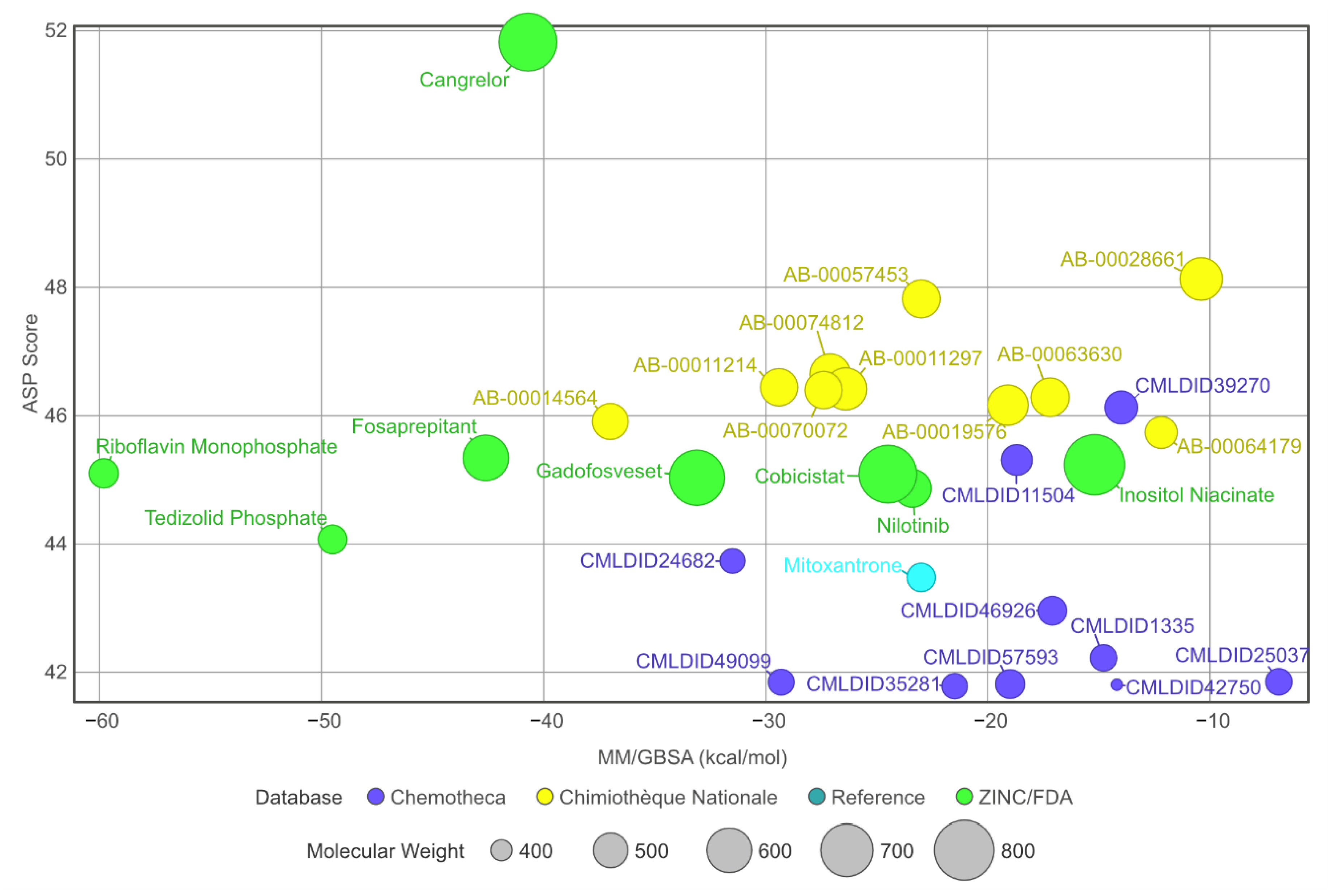
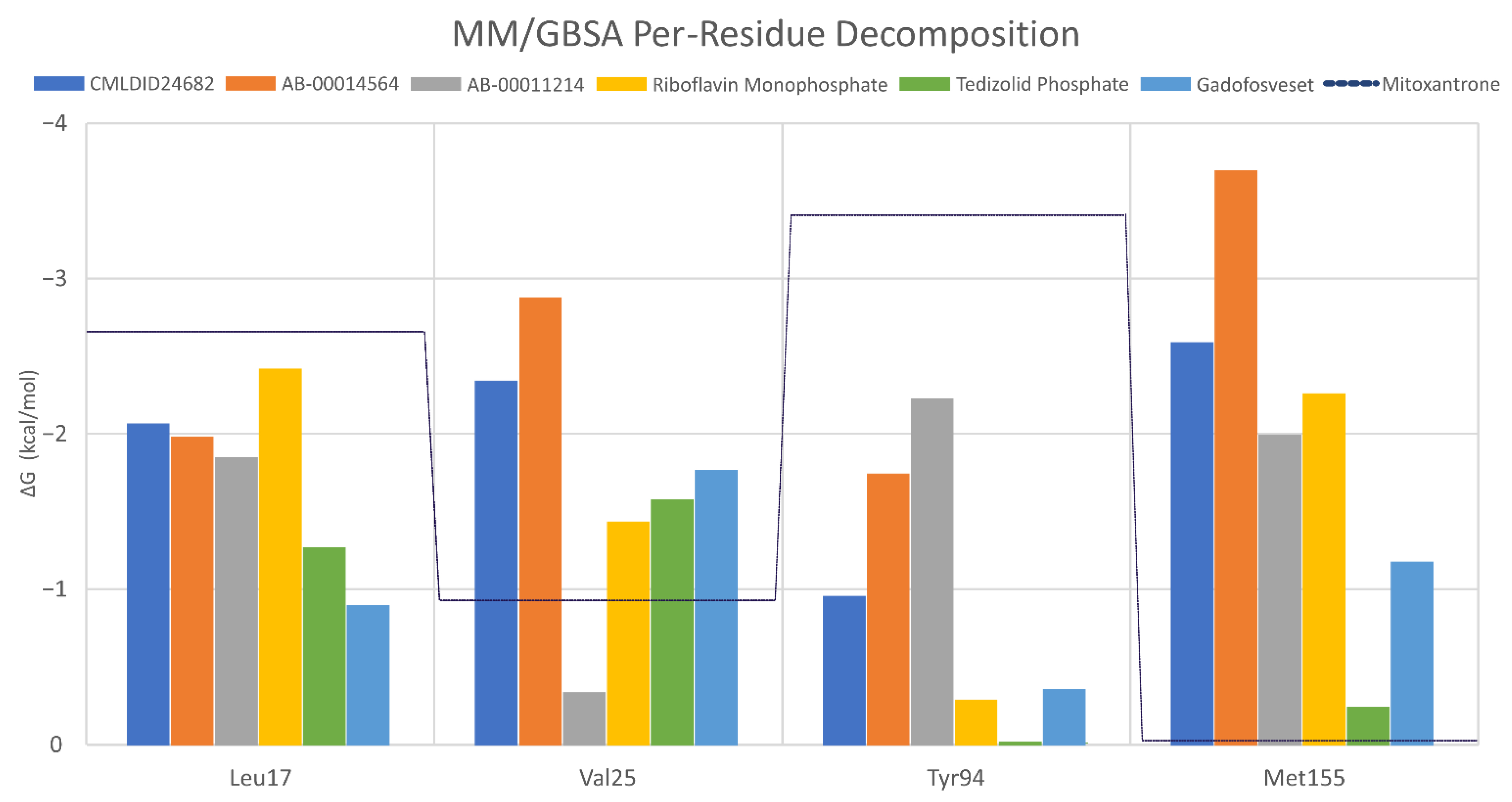
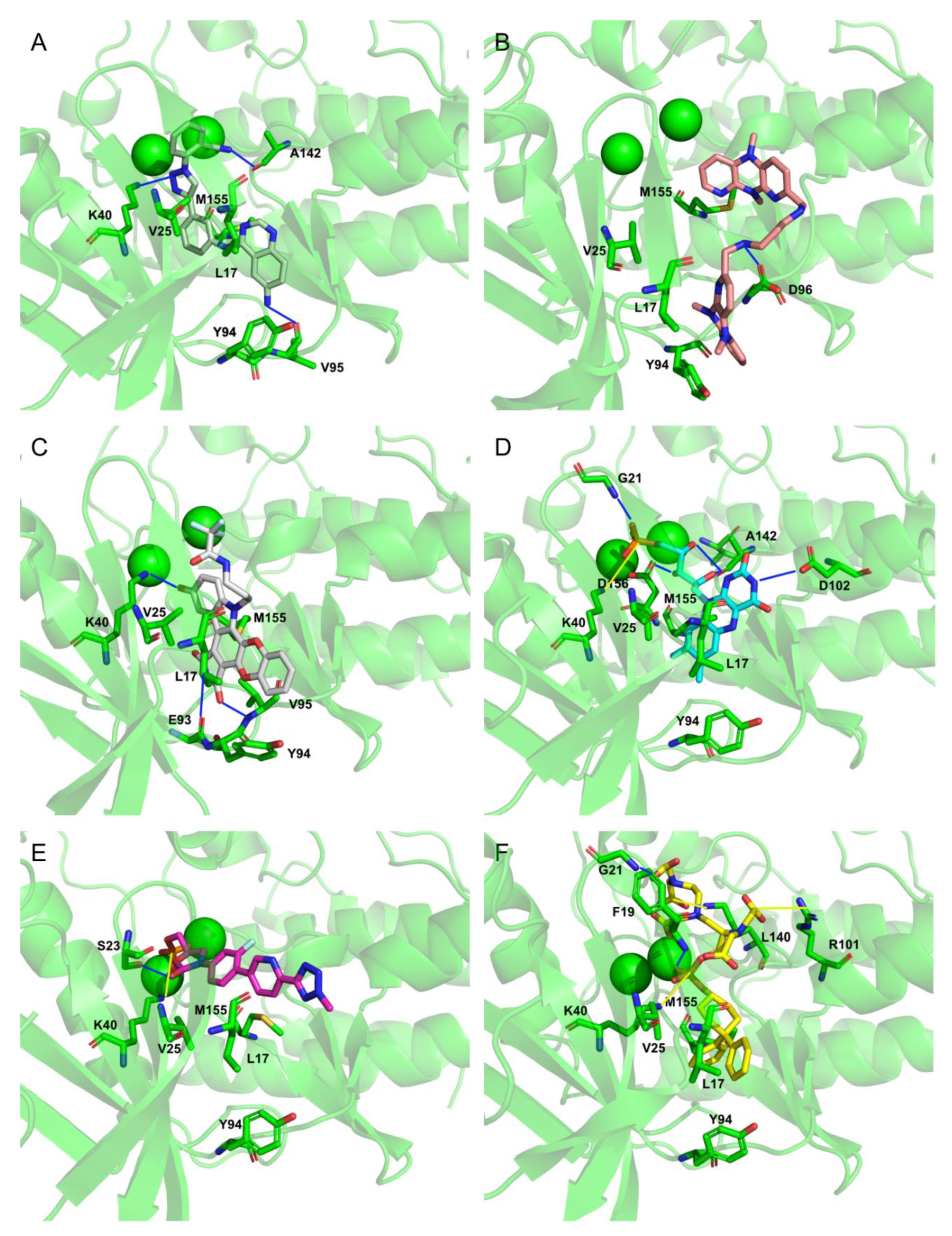
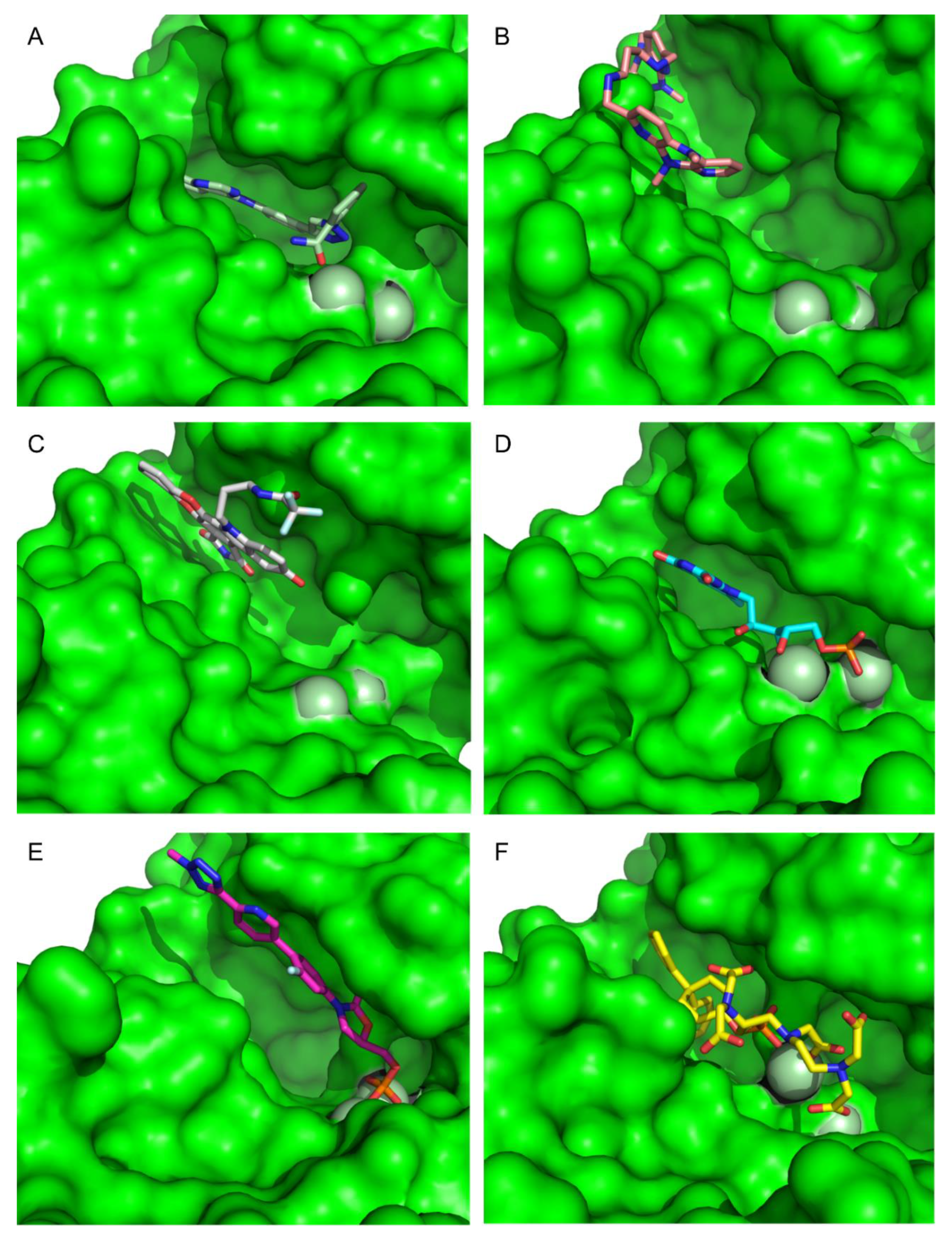
| Code | Ligand | Description | Resolution (Å) | Metal ion | Mutation | Ref. |
|---|---|---|---|---|---|---|
| 1MRU | ATP analog | Chains A, B | 3.00 | Mg2+ | 0 | [17] |
| 1O6Y | ATP analog | Catalytic Domain | 2.20 | Mg2+ | 0 | [16] |
| 2FUM | Antagonist | Chains A, B, C, D | 2.89 | - | 0 | [18] |
| 3F61 | ATP analog | Catalytic Domain | 1.80 | Mg2+ | 2 (L33D/V222D) | [31] |
| 3F69 | Antagonist | Chains A, B | 2.80 | - | 3 (L36D/M148L/M158V) | [31] |
| 3ORI | ATP analog | Chains A, B, C, D | 2.00 | Mn2+ | 1 (L33D) | [32] |
| 3ORK | ATP analog | Catalytic Domain | 1.60 | Mn2+ | 1 (L33D) | [32] |
| 3ORL | ATP analog | Catalytic Domain | 2.90 | Mn2+ | 1 (L33D) | [32] |
| 3ORM | ATP analog | Catalytic Domain | 2.50 | Mn2+ | 1 (D76A) | [32] |
| 3ORO | ATP analog | Catalytic Domain | 1.90 | - | 1 (L33D) | [32] |
| 3ORP | ATP analog | Catalytic Domain | 2.10 | - | 1 (L33D) | [32] |
| 3ORT | ATP analog | Catalytic Domain | 1.90 | - | 1 (L33D) | [32] |
| 5U94 | Antagonist | Catalytic Domain | 2.20 | Mg2+ | 0 | [33] |
| 6B2P | Antagonist | Catalytic Domain | 3.01 | - | 0 | [34] |
| 6I2P | ATP analog | Bound to GarA 1 | 2.37 | Mg2+ | 1 (L33E) | [35] |
| PDB Code | Ligand | Vina | CHEMPLP | ASP | ChemScore | GoldScore | Average per Target 1 |
|---|---|---|---|---|---|---|---|
| 1MRU | ATP analog | 0.57 | 4.98 | 2.42 | 6.77 | 2.35 | 3.42 ± 2.45 |
| 1O6Y | ATP analog | 0.82 | 1.38 | 1.43 | 2.43 | 1.13 | 1.44 ± 0.61 |
| 2FUM | Antagonist | 0.84 | 2.01 | 1.94 | 2.40 | 2.37 | 1.91 ± 0.63 |
| 3F61 | ATP analog | 0.18 | 1.53 | 1.72 | 5.14 | 0.63 | 1.84 ± 1.95 |
| 3F69 | Antagonist | 0.50 | 0.31 | 0.56 | 0.81 | 0.81 | 0.60 ± 0.21 |
| 3ORI | ATP analog | 0.51 | 3.33 | 0.93 | 2.77 | 3.33 | 2.17 ± 1.36 |
| 3ORK | ATP analog | 3.25 | 1.61 | 1.46 | 3.63 | 2.11 | 2.41 ± 0.97 |
| 3ORL | ATP analog | 1.17 | 2.79 | 2.31 | 3.00 | 3.07 | 2.47 ± 0.78 |
| 3ORM | ATP analog | 1.68 | 3.5 | 1.49 | 3.06 | 3.9 | 2.73 ± 1.08 |
| 3ORO | ATP analog | 0.74 | 1.37 | 2.8 | 2.85 | 0.85 | 1.72 ± 1.03 |
| 3ORP | ATP analog | 1.16 | 2.58 | 2.37 | 2.33 | 0.5 | 1.79 ± 0.91 |
| 3ORT | ATP analog | 0.22 | 2.55 | 1.79 | 2.58 | 2.33 | 1.89 ± 0.99 |
| 5U94 | Antagonist | 0.25 | 0.04 | 1.14 | 5.97 | 0.60 | 1.60 ± 2.47 |
| 6B2P | Antagonist | 2.81 | 1.40 | 1.88 | 3.46 | 6.00 | 3.11 ± 1.80 |
| 6I2P | ATP analog | 1.68 | 1.10 | 1.35 | 1.13 | 2.23 | 1.50 ± 0.47 |
| Average per SF 2 | 1.09 ± 0.92 | 2.03 ± 1.28 | 1.70 ± 0.61 | 3.22 ± 1.63 | 2.15 ± 1.52 |
| 1O6Y | 3F61 | |||||||||
|---|---|---|---|---|---|---|---|---|---|---|
| EF 1% | AUC% | TG | RIE | BEDROC | EF 1% | AUC | TG | RIE | BEDROC | |
| CHEMPLP | 1.88 | 63.7 | 0.18 | 1.44 | 0.08 | 0.00 | 60.6 | 0.12 | 0.65 | 0.04 |
| ASP | 3.76 | 80.9 | 0.40 | 3.19 | 0.19 | 1.88 | 80.6 | 0.40 | 2.87 | 0.17 |
| ChemScore | 1.88 | 51.4 | 0.02 | 0.73 | 0.04 | 0.00 | 50.1 | 0.01 | 0.65 | 0.04 |
| GoldScore | 1.88 | 66.7 | 0.24 | 2.58 | 0.15 | 0.00 | 50.6 | 0.02 | 1.00 | 0.06 |
| Database | Molecules | Average RMSD (Å) 1 | RMSF (Å) | Average SASA (Å2) 1 | Percentage of Potential Ligand SASA Buried (%) | Average # H-Bonds 1 |
|---|---|---|---|---|---|---|
| Mu.Ta.Lig Chemotheca | CMLDID11504 | 3.56 ± 0.67 | 1.4 | 199 ± 65 | 53 ± 3 | 0.3 |
| CMLDID1335 | 1.74 ± 0.41 | 1.2 | 395 ± 43 | 51 ± 5 | 0.4 | |
| CMLDID24682 | 0.69 ± 0.12 | 0.3 | 194 ± 172 | 57 ± 3 | 1.5 | |
| CMLDID35281 | 2.26 ± 0.73 | 1.4 | 374 ± 119 | 50 ± 4 | 0.3 | |
| CMLDID39270 | 2.44 ± 0.60 | 1.8 | 230 ± 48 | 52 ± 3 | 0.3 | |
| CMLDID42750 | 1.58 ± 0.44 | 1.4 | 182 ± 48 | 58 ± 3 | 0.3 | |
| CMLDID46926 | 1.88 ± 0.54 | 1.4 | 235 ± 49 | 55 ± 3 | 0.4 | |
| CMLDID49099 | 1.29 ± 0.32 | 0.9 | 265 ± 30 | 56 ± 6 | 1 | |
| CMLDID57593 | 1.93 ± 0.40 | 1.1 | 303 ± 27 | 45 ± 3 | 0.4 | |
| CMLDID25037 | 2.17 ± 0.30 | 1.2 | 284 ± 39 | 42 ± 4 | 0.2 | |
| Chimiothèque Nationale | AB-00011214 | 2.92 ± 0.26 | 1.3 | 394 ± 116 | 61 ± 3 | 0.9 |
| AB-00011297 | 1.48 ± 0.36 | 1.1 | 570 ± 143 | 51 ± 4 | 0.5 | |
| AB-00014564 | 2.47 ± 0.57 | 1.1 | 187 ± 47 | 48 ± 5 | 2 | |
| AB-00019576 | 2.39 ± 0.47 | 1.6 | 413 ± 165 | 45 ± 6 | 0.6 | |
| AB-00028661 | 3.75 ± 0.47 | 1.7 | 448 ± 47 | 53 ± 4 | 1.4 | |
| AB-00057453 | 2.50 ± 0.80 | 1.8 | 338 ± 68 | 48 ± 6 | 0.6 | |
| AB-00063630 | 2.03 ± 0.34 | 1.1 | 239 ± 38 | 59 ± 4 | 0.6 | |
| AB-00064179 | 1.87 ± 0.49 | 1 | 317 ± 33 | 49 ± 4 | 0.7 | |
| AB-00070072 | 1.15 ± 0.37 | 0.8 | 328 ± 26 | 50 ± 3 | 0.1 | |
| AB-00074812 | 3.91 ± 1.18 | 2.9 | 542 ± 101 | 63 ± 3 | 1.3 | |
| ZINC/ FDA | Inositol Niacinate | 1.77 ± 0.19 | 1 | 624 ± 135 | 50 ± 5 | 0.2 |
| Riboflavin Monophosphate | 0.70 ± 0.17 | 0.3 | 188 ± 31 | 49 ± 4 | 0.9 | |
| Fosaprepitant | 1.99 ± 0.36 | 0.8 | 408 ± 67 | 57 ± 2 | 0.3 | |
| Nilotinib | 2.51 ± 1.34 | 2.2 | 325 ± 69 | 50 ± 3 | 0.3 | |
| Gadofosveset | 3.96 ± 0.40 | 2 | 478 ± 51 | 53 ± 2 | 3.6 | |
| Tedizolid Phosphate | 1.33 ± 0.34 | 0.9 | 266 ± 67 | 51 ± 4 | 0.6 | |
| Cobicistat | 3.89 ± 1.29 | 2.9 | 607 ± 82 | 53 ± 5 | 0.7 | |
| Cangrelor | 2.27 ± 0.27 | 1.2 | 388 ± 216 | 57 ± 5 | 0.2 | |
| Reference | Mitoxantrone | 1.94 ± 0.30 | 1.3 | 401 ± 116 | 62 ± 3 | 1.3 |
| MM | GBSA | ∆Gbinding | ||||
|---|---|---|---|---|---|---|
| Database | Ligand | Evdw (kcal/mol) | Eel (kcal/mol) | ESURF (kcal/mol) | EGB (kcal/mol) | MM/GBSA (kcal/mol) |
| Mu.Ta.Lig Chemotheca | CMLDID11504 | −38.8 ± 0.2 | −77.6 ± 0.3 | −5.8 ± 0.0 | 103.5 ± 0.3 | −18.7 ± 0.2 |
| CMLDID1335 | −19.3 ± 0.2 | −265.0 ± 2.0 | −2.5 ± 0.0 | 272.1 ± 1.9 | −14.8 ± 0.2 | |
| CMLDID24682 | −46.1 ± 0.1 | −111.4 ± 0.2 | −6.8 ± 0.0 | 132.8 ± 0.2 | −31.5 ± 0.1 | |
| CMLDID35281 | −29.6 ± 0.1 | −115.6 ± 1.0 | −3.2 ± 0.1 | 126.9 ± 0.9 | −21.5 ± 0.1 | |
| CMLDID39270 | −37.4 ± 0.2 | −79.7 ± 0.4 | −5.4 ± 0.0 | 108.5 ± 0.3 | −14.0 ± 0.2 | |
| CMLDID42750 | −37.4 ± 0.2 | −58.7 ± 0.2 | −5.4 ± 0.0 | 87.3 ± 0.2 | −14.2 ± 0.1 | |
| CMLDID46926 | −39.2 ± 0.2 | −15.9 ± 0.3 | −4.8 ± 0.0 | 42.8 ± 0.4 | −17.1 ± 0.2 | |
| CMLDID49099 | −39.2 ± 0.1 | −160.8 ± 0.5 | −5.3 ± 0.0 | 176.0 ± 0.5 | −29.3 ± 0.1 | |
| CMLDID57593 | −29.6 ± 0.1 | −2.6 ± 0.1 | −3.1 ± 0.0 | 16.3 ± 0.1 | −19.0 ± 0.1 | |
| CMLDID25037 | −31.7 ± 0.2 | −81.8 ± 0.4 | −5.1 ± 0.0 | 111.8 ± 0.3 | −6.9 ± 0.2 | |
| Chimiothèque Nationale | AB-00011214 | −43.4 ± 0.1 | −244.6 ± 0.8 | −5.2 ± 0.0 | 263.7 ± 0.7 | −29.4 ± 0.2 |
| AB-00011297 | −40.1 ± 0.2 | −114.1 ± 0.4 | −4.1 ± 0.0 | 131.9 ± 0.4 | −26.4 ± 0.1 | |
| AB-00014564 | −49.2 ± 0.2 | −41.5 ± 0.3 | −6.1 ± 0.0 | 59.9 ± 0.2 | −37.0 ± 0.1 | |
| AB-00019576 | −45.8 ± 0.1 | −73.7 ± 0.3 | −6.8 ± 0.0 | 107.1 ± 0,2 | −19.1 ± 0.2 | |
| AB-00028661 | −31.4 ± 0.2 | −197.8 ± 0.7 | −5.5 ± 0.0 | 224.3 ± 0.7 | −10.4 ± 0.2 | |
| AB-00057453 | −37.8 ± 0.2 | −219.4 ± 0.8 | −4.3 ± 0.0 | 238.5 ± 0.7 | −23.0 ± 0.1 | |
| AB-00063630 | −42.3 ± 0.1 | −70.2 ± 0.3 | −6.6 ± 0.0 | 101.9 ± 0.2 | −17.2 ± 0.1 | |
| AB-00064179 | −33.2 ± 0.1 | −55.0 ± 0.3 | −4.8 ± 0.0 | 80.8 ± 0.2 | −12.2 ± 0.1 | |
| AB-00070072 | −42.7 ± 0.1 | 7.6 ± 0.1 | −4.8 ± 0.0 | 12.5 ± 0.1 | −27.4 ± 0.1 | |
| AB-00074812 | −30.1 ± 0.2 | −340.0 ± 1.3 | −4.6 ± 0.0 | 347.6 ± 1.2 | −27.1 ± 0.2 | |
| ZINC/ FDA | Inositol Niacinate | −35.7 ± 0.2 | −5.7 ± 0.3 | −4.6 ± 0.0 | 30.8 ± 0.3 | −15.2 ± 0.1 |
| Riboflavin Monophosphate | −16.1 ± 0.2 | −584.8 ± 0.9 | −6.5 ± 0.0 | 547.7 ± 0.8 | −59.8 ± 0.3 | |
| Fosaprepitant | 2.4 ± 0.2 | −486.5 ± 0.7 | −3.6 ± 0.0 | 445.1 ± 0.6 | −42.6 ± 0.3 | |
| Nilotinib | −38.4 ± 0.3 | −17.9 ± 0.5 | −5.1 ± 0.0 | 38.0 ± 0.6 | −23.4 ± 0.2 | |
| Gadofosveset | −25.0 ± 0.3 | −518.5 ± 1.7 | −7.1 ± 0.0 | 517.4 ± 1.6 | −33.1 ± 0.3 | |
| Tedizolid Phosphate | −6.6 ± 0.2 | −565.6 ± 0.8 | −4.1 ± 0.0 | 526 ± 0.7 | −49.5 ± 0.3 | |
| Cobicistat | −39.6 ± 0.2 | −115.2 ± 0.6 | −5.2 ± 0.0 | 135.5 ± 0.6 | −24.5 ± 0.2 | |
| Cangrelor | −58.5 ± 0.1 | −86.7 ± 0.3 | −8.2 ± 0.0 | 112.8 ± 0.3 | −40.7 ± 0.2 | |
| Reference | Mitoxantrone | −31.9 ± 0.2 | −295.3 ± 1.1 | −4.2 ± 0.0 | 308.4 ± 1.0 | −23.0 ± 0.2 |
| Drug Name | Description | Structure |
|---|---|---|
| Riboflavin Monophosphate | Riboflavin Monophosphate is a form of vitamin B2 used to restore riboflavin in anaemia, migraine, alcoholism, and hyperhomocysteinemia [73]. | 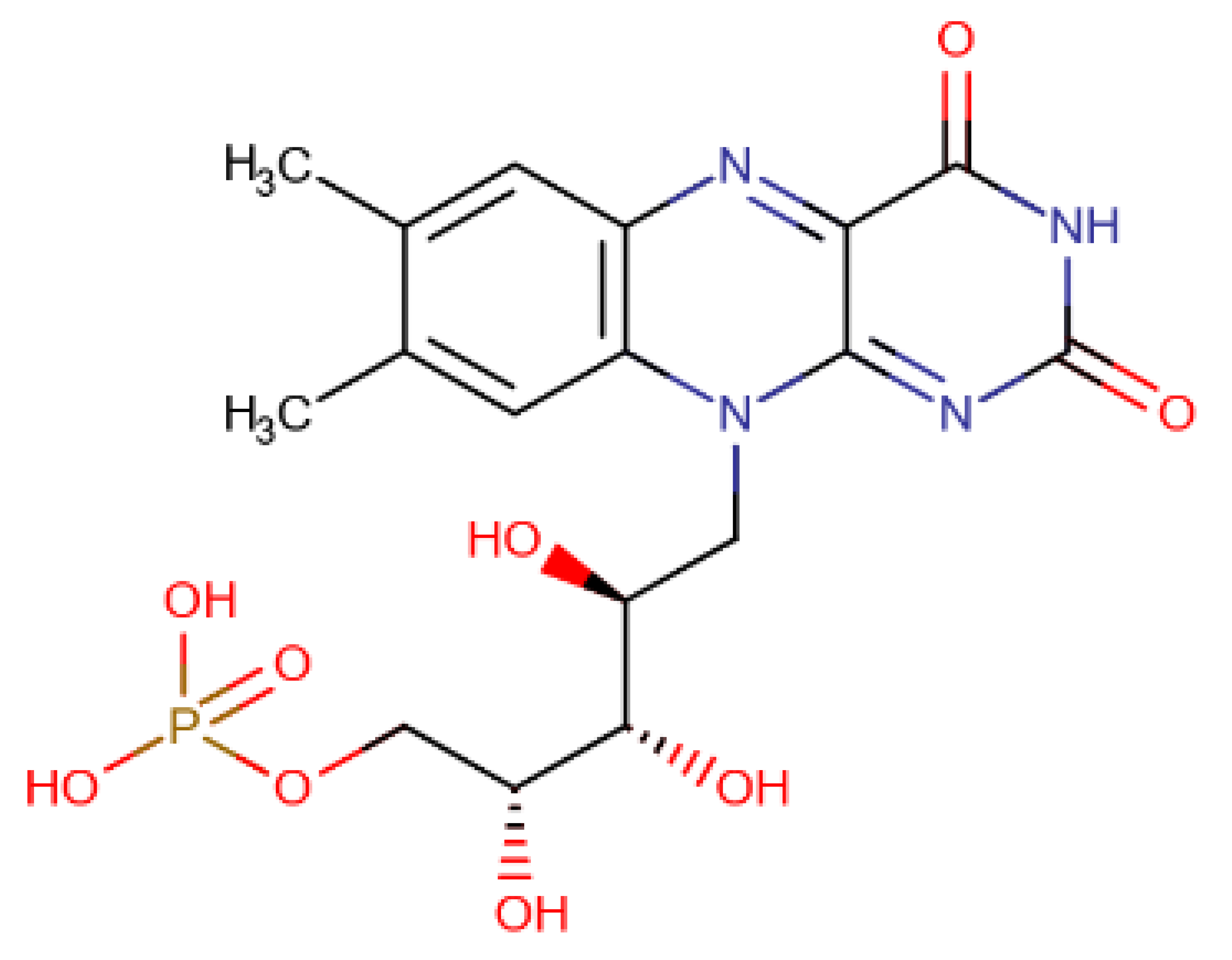 |
| Tedizolid phosphate | Tedizolid phosphate is a member of the oxazolidinone class of antibiotics. It is effective in the treatment of certain Gram-positive bacterial infections. It works by inhibiting protein synthesis by bacterial ribosomes [74]. | 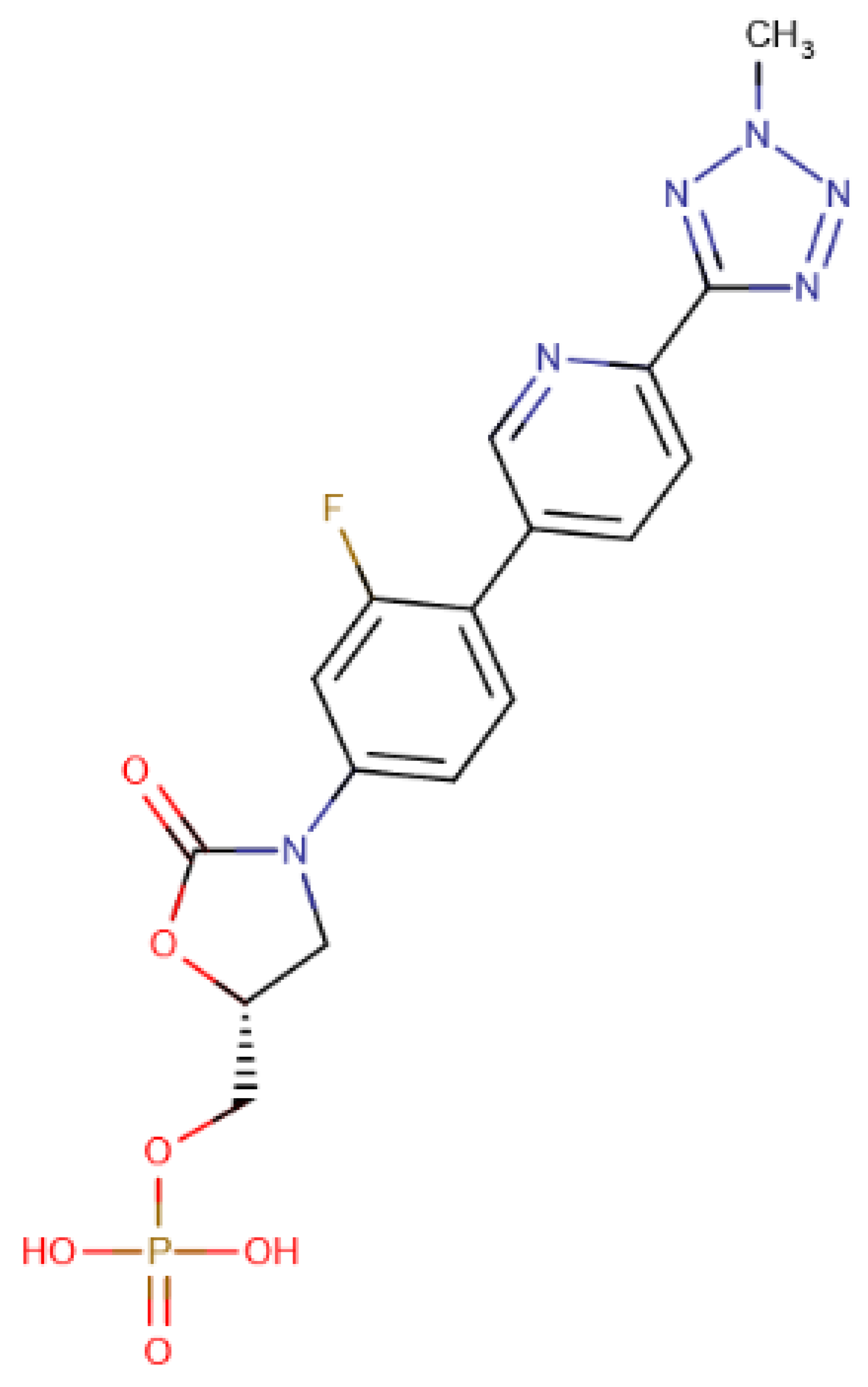 |
| Gadofosveset | Gadofosveset trisodium is an intravenous contrast agent used with magnetic resonance imaging [75]. | 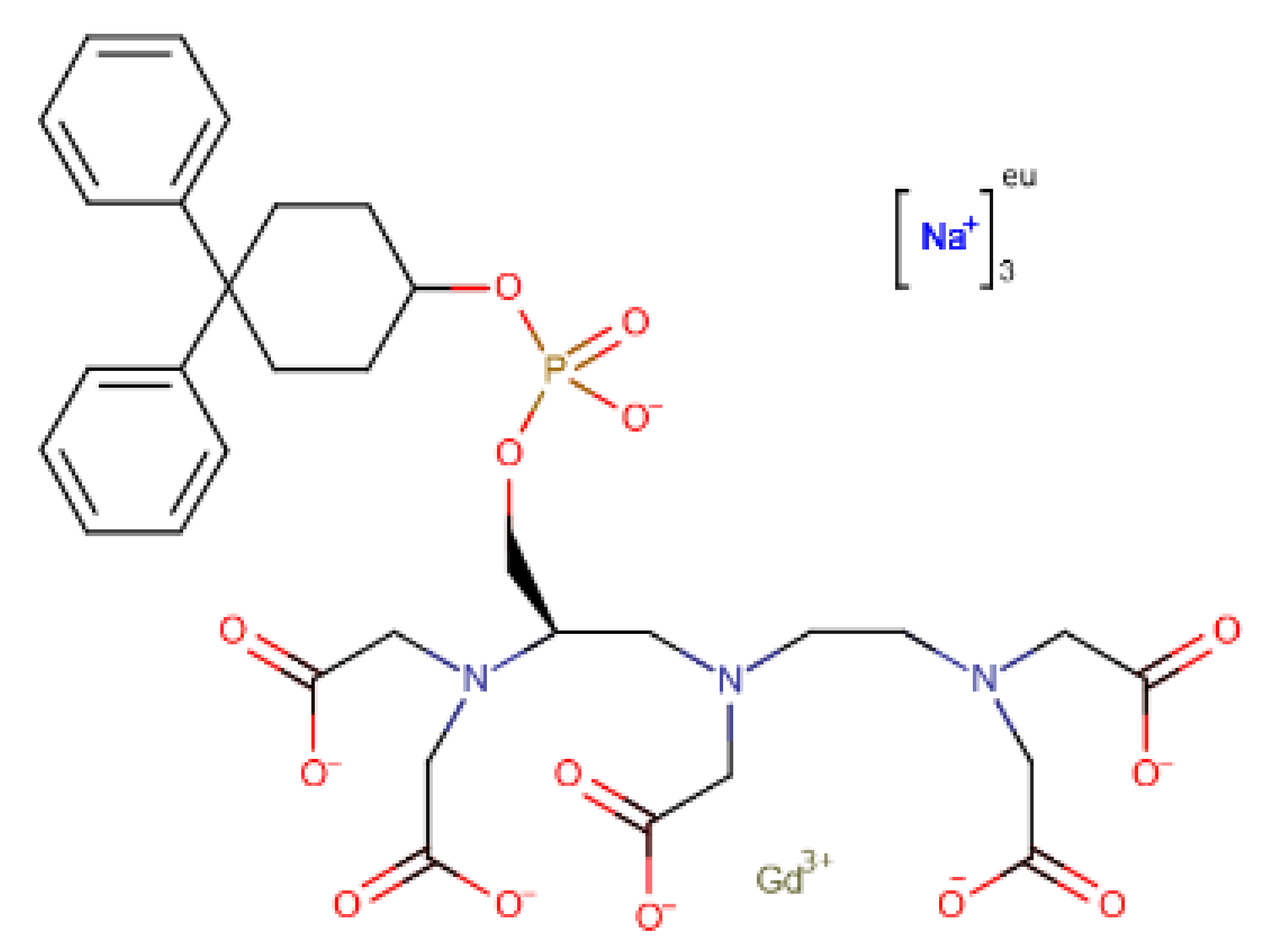 |
Publisher’s Note: MDPI stays neutral with regard to jurisdictional claims in published maps and institutional affiliations. |
© 2021 by the authors. Licensee MDPI, Basel, Switzerland. This article is an open access article distributed under the terms and conditions of the Creative Commons Attribution (CC BY) license (https://creativecommons.org/licenses/by/4.0/).
Share and Cite
Vieira, T.F.; Martins, F.G.; Moreira, J.P.; Barbosa, T.; Sousa, S.F. In Silico Identification of Possible Inhibitors for Protein Kinase B (PknB) of Mycobacterium tuberculosis. Molecules 2021, 26, 6162. https://doi.org/10.3390/molecules26206162
Vieira TF, Martins FG, Moreira JP, Barbosa T, Sousa SF. In Silico Identification of Possible Inhibitors for Protein Kinase B (PknB) of Mycobacterium tuberculosis. Molecules. 2021; 26(20):6162. https://doi.org/10.3390/molecules26206162
Chicago/Turabian StyleVieira, Tatiana F., Fábio G. Martins, Joel P. Moreira, Tiago Barbosa, and Sérgio F. Sousa. 2021. "In Silico Identification of Possible Inhibitors for Protein Kinase B (PknB) of Mycobacterium tuberculosis" Molecules 26, no. 20: 6162. https://doi.org/10.3390/molecules26206162
APA StyleVieira, T. F., Martins, F. G., Moreira, J. P., Barbosa, T., & Sousa, S. F. (2021). In Silico Identification of Possible Inhibitors for Protein Kinase B (PknB) of Mycobacterium tuberculosis. Molecules, 26(20), 6162. https://doi.org/10.3390/molecules26206162









